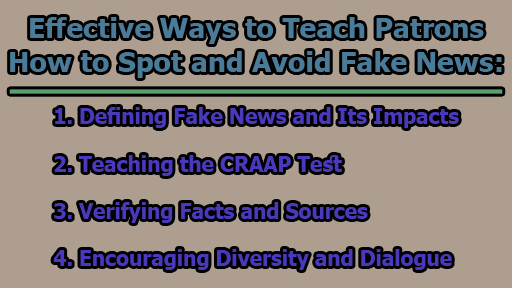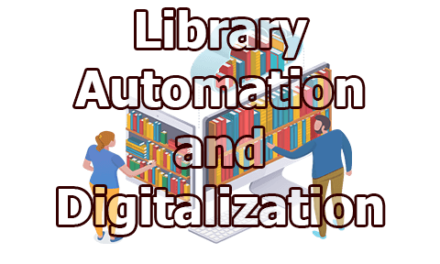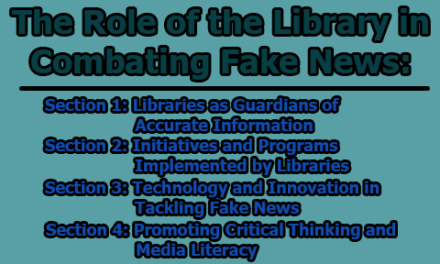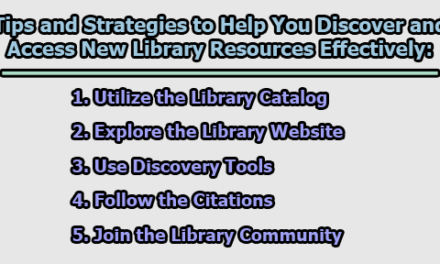Effective Ways to Teach Patrons How to Spot and Avoid Fake News:
In the age of information overload and the digital era, fake news has become a pervasive and concerning issue. It refers to deliberately misleading or false information that is disseminated online, often with political, ideological, or financial motives. Fake news can have severe consequences, impacting democracy, public health, and social cohesion. As library professionals, we have a unique responsibility to help our patrons develop the skills and habits necessary to recognize and evaluate fake news effectively. In this article, we will explore some of the most effective ways to teach patrons how to spot and avoid fake news, drawing upon principles of information literacy and digital literacy.
1. Defining Fake News and Its Impacts: The first step in educating patrons about fake news is to provide a clear definition and an understanding of why it matters. Presenting real-world examples of fake news stories from various sources and platforms and discussing their effects on people’s beliefs, emotions, and actions can be eye-opening. It is crucial to underline the ethical and legal consequences associated with creating and sharing fake news, including defamation, copyright infringement, and incitement to violence. By defining fake news and its impacts, we can help patrons comprehend the significance of being critical and responsible consumers and producers of information.
2. Teaching the CRAAP Test: The CRAAP test is a widely recognized tool for evaluating the credibility, relevance, accuracy, authority, and purpose of any information source. As library professionals, we can assist our patrons in applying the CRAAP test by encouraging them to ask a series of critical questions:
- Credibility: Who is the author or publisher, and what are their credentials and reputation?
- Relevance: When was the information published or updated, and is it current and timely?
- Accuracy: How reliable is the information, and are there any errors, inconsistencies, or contradictions?
- Authority: Why was the information created or shared, and what is the intended audience and goal?
- Purpose: What is the perspective or bias of the information, and is it objective and balanced, or does it aim to persuade or manipulate?
Teaching the CRAAP test equips patrons with the skills needed to assess the quality and reliability of any information source, enabling them to recognize fake news that fails to meet these criteria.
3. Verifying Facts and Sources: Another valuable method for teaching patrons how to identify fake news is by demonstrating how to verify facts and sources in a given piece of information. Library professionals can educate patrons on using fact-checking websites such as Snopes, FactCheck, or PolitiFact to determine if a claim or story has been verified or debunked by reputable experts. Additionally, patrons can learn how to employ reverse image searches, like Google Images or TinEye, to ascertain the origin and context of images or videos and detect whether they have been altered or manipulated. By teaching patrons how to verify facts and sources, we empower them to avoid fake news based on false or misleading evidence.
4. Encouraging Diversity and Dialogue: A crucial element of combating fake news is encouraging patrons to seek out diverse and credible sources of information and participate in respectful and constructive dialogue. Library professionals can recommend using different search engines, databases, and platforms to access a variety of information sources, such as news outlets, academic journals, government websites, or civil society organizations. Patrons should also be encouraged to compare and contrast different perspectives and opinions, listen to others with empathy and curiosity, and engage in thoughtful discussions. By promoting diversity and dialogue, we help patrons avoid fake news that is rooted in narrow or biased views and foster a culture of information literacy and digital literacy in our communities.
Indeed, creating an open and supportive learning environment is key when teaching patrons to identify and combat fake news effectively. Here are additional points to consider when developing strategies for educating patrons:
- Conduct Workshops and Training Sessions: Regular workshops and training sessions focused on media literacy and critical thinking can provide patrons with ongoing opportunities to enhance their skills and knowledge in spotting fake news.
- Develop a Structured Curriculum: Establish a well-structured curriculum that covers media literacy basics, ensuring that patrons have a systematic and comprehensive understanding of the subject.
- Provide Resources: Make available resources such as fact-checking websites and a list of reliable news sources, enabling patrons to fact-check information and access trustworthy news outlets.
- Engage in Critical Thinking Exercises and Discussions: Encourage critical thinking through exercises and discussions that challenge assumptions and promote the evaluation of information from multiple angles.
- Encourage Fact-Checking and Source Evaluation: Instill the habit of fact-checking and evaluating information sources before accepting and sharing content.
- Teach Skepticism: Train patrons to approach sensational headlines and claims with skepticism, emphasizing the need for evidence-based reasoning.
- Use Case Studies: Utilize case studies to illustrate the real-world impact of fake news, demonstrating how misinformation can affect society, politics, and individuals.
- Utilize Technology: Teach patrons to use technology tools for fact-checking and source verification, empowering them to employ online resources effectively.
- Promote Ethical Sharing of Information: Emphasize the ethical responsibility of sharing information and the potential consequences of spreading false or misleading content.
- Stay Updated on Evolving Tactics: Keep abreast of evolving tactics in misinformation, including deepfakes and other advanced techniques, so that patrons are prepared to identify and respond to new challenges.
- Provide Feedback and Assessments: Implement feedback mechanisms and assessments to measure patrons’ progress, allowing for continuous improvement and tailored guidance.
In conclusion, in an era inundated with information, the ability to discern real news from fake news is an essential skill. As library professionals, we play a vital role in educating our patrons about the risks associated with fake news and equipping them with the tools and knowledge needed to navigate the digital landscape effectively. By defining fake news, teaching the CRAAP test, demonstrating how to verify facts and sources, and encouraging diversity and dialogue, we empower our patrons to be discerning consumers and producers of information. Ultimately, this helps safeguard the integrity of our democracy, public health, and social cohesion in the face of the fake news epidemic.

Library Lecturer at Nurul Amin Degree College










